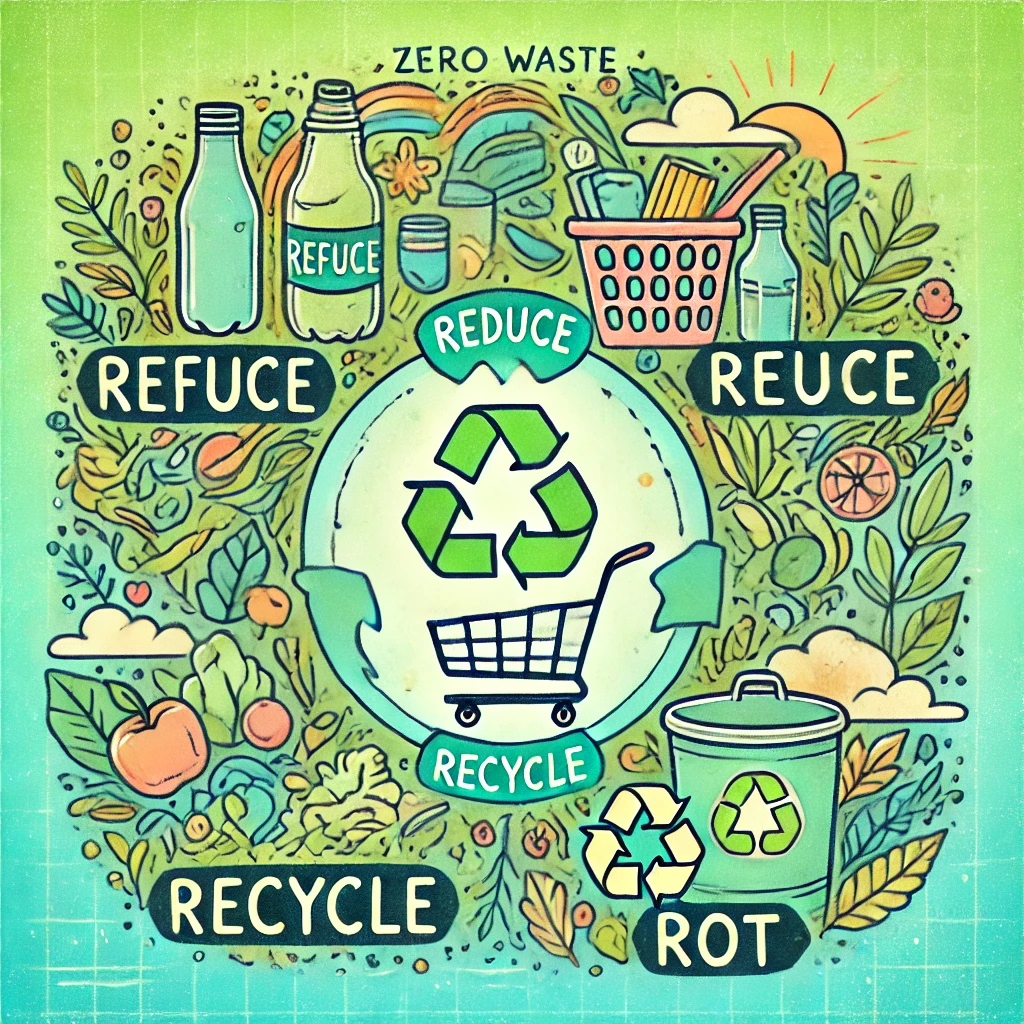
Sustainable Living and Eco-Friendly
How to Reduce Waste in Everyday Life


DINKAR
11/8/2024
Simple Tips for a Sustainable Future
In today’s world, the amount of waste we produce is becoming a growing concern. From overflowing landfills to environmental pollution, the consequences of waste accumulation are far-reaching. However, every small change we make in our daily habits can have a significant positive impact on the environment. Reducing waste in everyday life not only helps protect the planet but also promotes a more sustainable way of living. In this blog, we will explore practical and easy ways you can reduce waste in your day-to-day activities.
Why is Reducing Waste Important?
Before diving into actionable tips, it's important to understand why reducing waste is crucial for the environment. Here are a few reasons:
- Environmental Impact: Waste takes up space in landfills and contributes to soil and water contamination. Some waste materials take hundreds of years to decompose, during which they release harmful chemicals into the environment.
- Resource Conservation: Many products we use daily are made from non-renewable resources. By reducing waste, we can conserve raw materials, energy, and water that are required for the production of goods.
- Climate Change Mitigation: Decomposing waste in landfills generates methane, a potent greenhouse gas. Reducing waste helps lower emissions, which in turn helps mitigate climate change.
1. Embrace Reusable Products
One of the easiest ways to reduce waste in your daily life is to switch from single-use products to reusable alternatives. This change may seem small, but it can have a significant impact over time.
Reusable Bags
Plastic bags are one of the most common forms of waste worldwide. Instead of using plastic bags every time you shop, invest in reusable cloth bags. Keep them in your car or purse so you never forget them when you go to the store.
Reusable Water Bottles and Coffee Cups
Single-use plastic water bottles and coffee cups are major contributors to environmental waste. Opt for a reusable water bottle made from stainless steel, glass, or BPA-free plastic. Similarly, use a reusable coffee cup or thermos instead of taking your coffee in disposable cups.
Food Storage Containers
Instead of using plastic wrap or disposable bags, switch to glass or stainless steel containers to store food. Not only are these better for the environment, but they also keep your food fresher for longer.
2. Minimize Food Waste
Food waste is a major contributor to global waste. In the U.S., nearly 40% of food produced goes to waste. Here are a few simple steps to reduce food waste at home:
Plan Your Meals
Meal planning helps you buy only what you need, preventing impulse purchases that may end up going to waste. Take the time to plan meals for the week, create a shopping list, and stick to it.
Proper Food Storage
Learning how to store food correctly can help it last longer. For example, refrigerating vegetables like carrots and celery in water can extend their shelf life, while storing fruits like apples and bananas in separate places helps them stay fresh.
Composting
Composting is an excellent way to turn food scraps into nutrient-rich soil for your garden. Instead of throwing away peels, cores, and other organic waste, compost them to reduce the amount of trash in landfills and improve the health of your soil.
3. Reduce Paper Waste
Paper waste is another area where we can make a significant impact. Here’s how to minimize paper consumption:
Go Digital
One of the simplest ways to reduce paper waste is to go digital whenever possible. Opt for e-bills, digital documents, and online banking instead of printing paper. Use digital note-taking apps and calendars to minimize the use of paper notebooks and planners.
Recycle Paper
If you do need to use paper, make sure to recycle it. Avoid throwing used paper in the trash and instead place it in your recycling bin. Many offices and schools also offer paper recycling programs.
Buy Recycled Paper
If you need to purchase paper products, choose those made from recycled materials. Many companies now offer environmentally-friendly paper products, from notebooks and printer paper to napkins and tissues.
4. Choose Sustainable Clothing
Fast fashion is one of the largest contributors to global waste. Clothing that is cheaply made and worn only a few times ends up in landfills, where it can take years to break down. To reduce your clothing waste, follow these tips:
Buy Less, Choose Wisely
Instead of buying cheap, fast fashion items that wear out quickly, focus on purchasing fewer, higher-quality pieces that will last longer. Look for clothes made from natural fibers like cotton, wool, or linen, as these materials are more biodegradable than synthetic ones.
Upcycle and Repurpose
Before discarding old clothes, consider repurposing or upcycling them. You can transform an old t-shirt into a cleaning rag, or use fabric scraps to make small bags or accessories. Many thrift stores also accept donations of gently used clothing.
Care for Your Clothes
Extend the lifespan of your clothing by washing them less frequently and using gentle detergents. Hang dry clothes whenever possible to reduce wear and tear and avoid the energy consumption of dryers.
5. Be Mindful of Packaging
Packaging is a major source of waste, especially in food products and online shopping. Here’s how to reduce packaging waste:
Buy in Bulk
Buying in bulk reduces the need for individual packaging and helps you save money in the long run. Look for bulk bins in grocery stores to purchase grains, nuts, dried fruits, and other pantry staples.
Choose Minimal Packaging
When purchasing products, opt for items with minimal or recyclable packaging. For example, choose products with cardboard or paper packaging over those wrapped in plastic.
Use Eco-Friendly Packaging
Support brands that use eco-friendly packaging materials, such as biodegradable plastic, paper, or glass. You can also encourage businesses to adopt more sustainable practices by voting with your wallet.
6. Reduce Energy and Water Consumption
Another way to reduce waste is by lowering your energy and water usage. This not only helps the environment but can also save you money.
Switch to LED Bulbs
LED bulbs are energy-efficient and last longer than traditional incandescent bulbs. They use less power and help reduce your overall energy consumption, lowering your carbon footprint.
Turn Off Lights and Electronics
Make it a habit to turn off lights, appliances, and electronics when they’re not in use. You can also use power strips to easily disconnect multiple devices from the power supply.
Conserve Water
Fix leaky faucets and install water-saving devices like low-flow showerheads and toilets. Reducing water consumption helps conserve this precious resource and reduces the energy needed to pump, treat, and heat water.
7. Support Sustainable Brands and Local Products
Finally, one of the most impactful ways to reduce waste is by supporting brands and businesses that prioritize sustainability. Look for companies that use eco-friendly materials, offer recyclable packaging, or donate a portion of profits to environmental causes.
Buy Local
Supporting local businesses reduces the carbon footprint associated with the transportation of goods. Plus, local produce often requires less packaging and is typically fresher than items that have been shipped long distances.
Choose Eco-Friendly Products
Whether it's cleaning supplies, beauty products, or household goods, there are many sustainable alternatives on the market today. Look for products that are made from natural ingredients, are cruelty-free, and come in recyclable or compostable packaging.
Conclusion: Small Changes, Big Impact
Reducing waste in everyday life may seem like a daunting task, but it doesn’t have to be. By implementing small, simple changes in your daily routine, you can significantly reduce your environmental footprint and contribute to a more sustainable future. Start by embracing reusable products, minimizing food and paper waste, choosing sustainable clothing, and supporting eco-friendly brands. Every action counts, and together, we can make a big difference.